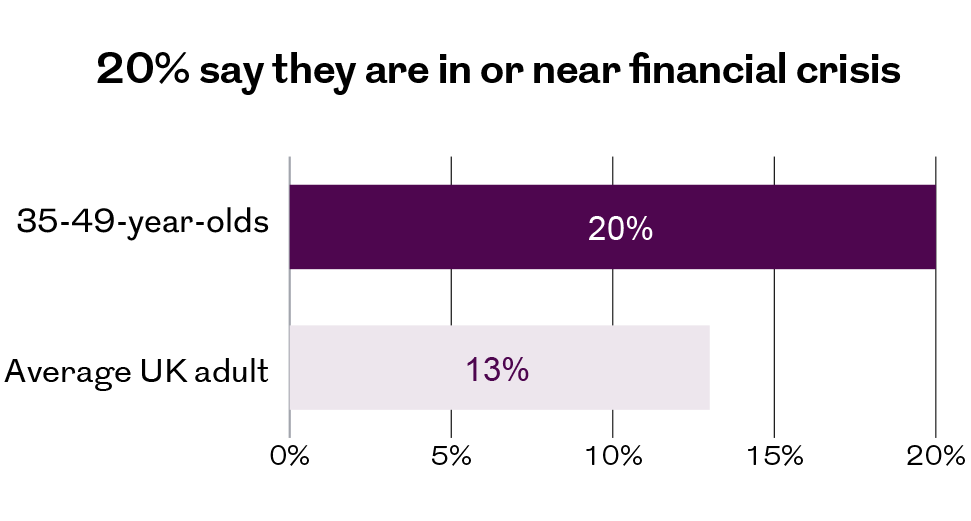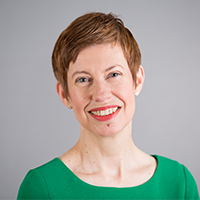Financial resilience report 2024 – Weathering the cost of living crisis
We’ve been tracking the effects of the rises in cost of living on people’s finances since the start of 2022, carrying out research every six months with a nationally representative sample of 4,000 UK adults.
We’ve been able to see how people have responded to the different phases of the cost of living crisis, from when energy, fuel and food bills were increasing in the early days, through to when interest rates rose throughout 2022 and for much of 2023.
As some costs start to come down and the cost of living crisis moves into a new phase, we wanted to look at the longer-term effects of two years of high costs and prices. How have people’s savings and debt levels been affected and what has it meant for their retirement plans? We have done this by looking at how the cost of living crisis has affected different age groups and how their financial resilience has been impacted.
To do this, we split our respondents into the following groups:
- Young adults – ages 18-34
- Family and career builders – ages 35-49
- Approaching and into retirement – ages 50-69
- Later life – ages 70 and older
Young adults – ages 18-34
People in this age group are just starting out in their working lives and learning to manage their finances. They are balancing rising housing costs, higher food and energy bills and other expenses with their earnings.
Key insights
- Rising housing costs have had a significant impact on this younger age group, especially those renting in the private sector where rent increases are particularly high.
- Over half of young people say their financial resilience has been affected by the cost of living crisis.
- The crisis has also affected their mental health and wellbeing with many experiencing money-related anxiety.
- Despite this, relatively few younger people said they had stopped paying into their pensions or reduced their contributions.

Housing headaches
Young renters are one of the groups most affected by higher housing costs, with 89% worried about rising rents versus 85% of all respondents. Almost four in ten (37%) of 18–34-year-olds rent their homes, 29% of whom rent from private landlords where increases have been steepest. As of February 2024, this age group are paying an average of £378 a month extra in housing costs, compared to a year earlier – the biggest increase of all the age groups.
As well as cutting back on spending, this age group are also regularly using their overdraft or borrowing at the end of the month, with almost one in three (31%) saying they do this. Interestingly, more younger adults said that they planned to borrow at the start of the crisis than this time around (41% in February 2022 versus 27% in February 2024).
The impact on mental health
Unsurprisingly, the cost of living crisis has taken a toll on people’s mental health and wellbeing, with this younger group suffering higher levels of anxiety (43%) over their lack of financial security compared to the whole sample (34%).
Our research found:
- 45% feel stressed versus 34% across all age groups
- 36% report lower mood compared to 30% for the overall sample
- Over a quarter of 18-34-year-olds feel ashamed about their lack of financial resilience and ability to cover costs – 26% versus 16% for the whole sample.
Less pessimistic pensions picture
Encouragingly, even though this age group have the most time before they retire, relatively low numbers have either stopped paying into their pension or reduced their contributions to pay for rising costs. Fewer than one in 20 (4%) said they had stopped their pension contributions entirely, while 2% had opted out of automatic enrolment and 2% had reduced their payments. While there is a balance between maintaining short and long-term financial resilience, most people in this group are finding other ways to adjust to the increased cost of living.
Family and career builders – ages 35-49
Career progression, settling down, and buying a home or moving to a bigger one are among the priorities for this age group. They have the highest average income of all age groups but are also the most likely to be overdrawn at the end of the month and to say that the cost of living has affected their financial resilience. In part, this is down to higher mortgage costs.
Key insights
- This group have both the highest employment level and average pay yet are the most likely to have had their financial resilience affected by the cost-of-living crisis.
- The effects of rising interest rates on mortgage costs, combined with higher monthly food and energy bills, make this group financially fragile.
- Inadequate insurance protection levels could leave this cohort exposed to the financial effects of unexpected life events.
Income under pressure
Despite having the highest average earnings of all age groups, 35-49-year-olds are the most likely to say they are in financial crisis or near to it, namely, unable to pay their major bills. One in five (20%) fall into this category, compared to 13% of the sample as a whole.
They also say they are less able to cope with the financial aspect of a life shock because of the cost of living crisis. Almost two-thirds (62%) say their financial resilience has been affected, compared to 55% of the sample as a whole.

More sensitive to mortgage rate rises
People in this age group are the most likely to own their homes with a mortgage (48% have a mortgage), while just 12% own their homes outright. Three in ten rent, with the majority (18%) doing so via a private landlord.
Unsurprisingly, given the prevalence of mortgage holders, they are the most likely to say that they have been affected by higher interest rates when taking a new fixed-rate mortgage after their existing deal expires (15% versus 8% of the whole sample). Add rising household bills to these costs and finances quickly come under strain. Once they have paid their bills, over one in three of those aged 35-49 are overdrawn some or all months or have to borrow – the highest of all age groups.
Financial protection
Of all the age groups, more people in the 35-49 cohort have life insurance than any other. This is understandable as they are more likely to have financial commitments as well as children or others who depend on them financially.
- 34% of this age group have some form of life insurance, compared to 27% of the sample as a whole.
- Almost twice as many have critical illness cover (15% compared to 8% for all adults).
- More people in this group have a mortgage than life insurance, which could leave a partner or spouse in a financially vulnerable position in the event of an unexpected death.
Shrinking savings
Almost one in four (23%) of 35-49-year-olds say they have no savings at all, which is markedly higher than the sample as a whole, where 15% have no savings. A real cause for concern is that almost one in five (17%) of this group say they couldn’t cover any size of unexpected bill, no matter how small, from either their income or savings. This compares to 10% of the sample as a whole.
This is significant because the lower the amount of unexpected expense that someone can cope with, the higher the likelihood that they will be in or near financial crisis. Overall, this age group have relatively low financial resilience after two years of the cost of living crisis. Higher mortgage rates combined with sizeable increases in other bills have contributed to this.
Potential pensions problems ahead?
Similar to the other age groups, only a small percentage of people in this cohort have stopped or reduced their pension contributions (6%) to cover higher living costs. Of those who have, 82% said they did so because they couldn’t afford the payments, the highest of all age groups (74% for the whole sample).
Over the last two years, only four in ten (39%) say they have thought about how much they might need per month in retirement. However, when it comes to details and actual calculations, 23% of this group don’t know how much they are contributing to their pensions each month. This limited understanding of their pension provision may not bode well for their long-term financial planning and aspirations for the future. However, like their Young Adult peers, they have time to seek advice or guidance to ensure they are saving enough for life after work.
Approaching and into retirement – ages 50-69
People in this age group may be approaching the end of their working lives and considering retirement. They may also be caring for ageing parents, supporting (grown up) children, dealing with bereavement or facing deteriorating health. A major consideration is how much money they will need to have a good standard of living in retirement.
Key insights
- This group are most likely to say the cost of living crisis has affected their retirement plans.
- A high percentage don’t know if they’re saving enough for life after work.
- Over half of our 50-69-year-old respondents own their homes outright, and this group have the biggest divide between those who are asset-rich and asset-poor.
Mixed employment status
Only a third of people aged between 50 and 69 work full time, with half that number (16%) working part time. Of the rest, almost a third are retired and not working, while a further 3% are retired but working in some capacity. This group also have the highest percentage of people who are disabled and unable to work (7%).
Income and spending
The mixed working status of this age group means they have a lower average income than the younger age groups – £26,203 per year compared to £28,484 for the sample as a whole.
However, they also experienced a smaller increase in household bills, spending an average of £430.61 a month extra on housing, food and energy bills compared to a year earlier, versus over £523 for the sample as a whole. Despite this, over one in five 50-69-year-olds (21%) say they are overdrawn always or some months or have to borrow at the end of the month.
Savvy savers
While almost one in six (15%) aged 50-69 have no savings, a further 15% say they have more than £50,000 set aside. That’s three times the percentage of both 18-34-year-olds and 35-49-year-olds.
With more funds at their disposal, it is not surprising that this group have used more of their short-term savings to pay for the cost of living rises over the last two years than any other. They have used an average of £3,851 compared to an overall average of £3,301. Almost one in five (17%) plan to use their short-term savings for any additional expenditure, which is in line with the overall sample (16%).
Asset-rich versus asset-poor
Over half of 50-69-year-olds (56%) own their homes outright and 20% own with a mortgage, while 21% rent. The high proportion of mortgage-free homeowners means this group have been insulated from some of the effects of rising mortgage rates. With more savings set aside, they have also benefited more than the younger savers from higher interest rates. Since March 2023 almost a third (32%) say that the interest rate on their savings has risen, compared to only one in four (24%) of the Young adults group and approximately one in five (21%) of those in the Family and career builders cohort.
Pension priorities
With life after work looming large for people in this group, and almost a third having retired already, they are most likely to say that the cost-of-living crisis has affected their retirement plans. Almost four out of five (79%) are in this category compared to three quarters (75%) of the whole sample. As a result of the crisis, 7% have delayed their retirement, while 30% say they will have less money when they stop working, compared to 24% across all age groups.
Overall, more than four in ten (43%) people in this age group think they’re saving enough into their pension for their retirement, the largest percentage of all working age groups (36% for the whole sample). However, our research shows that almost four in ten (39%) have never worked out how much they may need in retirement.

Later life – ages 70 and over
Most people in this group are retired and their retirement is likely funded through a mixture of workplace pensions, personal pensions and the State Pension. They tend to be more property-rich than other generations with the majority owning their homes outright.
Key insights
- Three in four of this group say the cost-of-living crisis has affected their retirement. Worryingly, over one in four don’t know if they have saved enough for later life.
- Their average income is significantly lower than the threshold for a moderate standard of living in retirement, as defined by independent research for the Pensions and Lifetime Savings Association.
- Despite this, they are more likely than any other group to consider themselves financially comfortable.
Income in retirement
People in this group receive an income largely from their pensions, sometimes supplemented by interest or income from savings and/or investments. Only 1% are still working. Their average annual personal income is £22,932, with over four in ten (45%) having an income of less than £30,000 a year.
Independent research from the Pensions and Lifetime Savings Association’s Retirement Living Standards (updated in February 2024) shows that a single person needs £31,300 a year to have a moderate standard of living in retirement, excluding any housing costs. Therefore, almost half of those in this group are falling short of this income threshold. However, 60% of those aged 70+ think they have saved enough for their retirement, only 13% say they haven’t, while one in four (27%) don’t know.
Covering their costs
Once they’ve paid all their bills, half this group (50%) have money left over at the end of the month, which is in line with the sample as a whole. Unsurprisingly, given the lower income levels of the over-70s compared to younger respondents, the amount they have spare is less, at £322.60 versus £389.12.
This group have taken a range of measures to reduce their day-to-day spending, but over one in five (22%) have used some of their savings to pay for rises in living costs (with a further 1% having used all their savings). Of those who have used savings in the last two years, one in four say they have used retirement savings (24% versus 15% of the overall sample).
Savings and assets
With fewer demands on their income than the younger groups, those in the 70+ cohort have more put aside in savings. Their average short-term savings are £24,756 compared to £15,549 for the sample as a whole. Only 7% have less than £100 in the bank, compared to 19% of the full sample.
However, one in ten have less than £10,000 in assets and 8% have less than £50,000 in assets. While this compares favourably to the other age groups, it is a concern. Those aged 70+ are not earning and are therefore more reliant on growth and/or income from their investments (including their pension) or interest on their savings. And, if they are not already doing so, they are more likely to be taking money out of their pension in the coming years.

Notes for editors
Five waves of research into the cost of living have been carried out for Royal London. The sample size and fieldwork dates are:
- Wave 1 - Research carried out by Opinium through an online survey with a sample of 4,001 UK adults between 24 February and 1 March 2022.
- Wave 2 - Research carried out by Opinium through an online survey with a sample of 4,000 UK adults between 26 August 1 September 2022.
- Wave 3 - Research carried out by Opinium through an online survey with a sample of 4,006 UK adults between 27 February and 6 March 2023.
- Wave 4 - Research carried out by YouGov Plc. The total sample size was 4,222 adults. Fieldwork was undertaken between 25 August and 10 September 2023. The survey was carried out online. The figures have been weighted and are representative of all UK adults (aged 18+).
- Wave 5 - Research carried out by YouGov Plc. The total sample size was 4,018 adults. Fieldwork was undertaken between 22 February and 7 March 2024. The survey was carried out online. The figures have been weighted and are representative of all UK adults (aged 18+).





